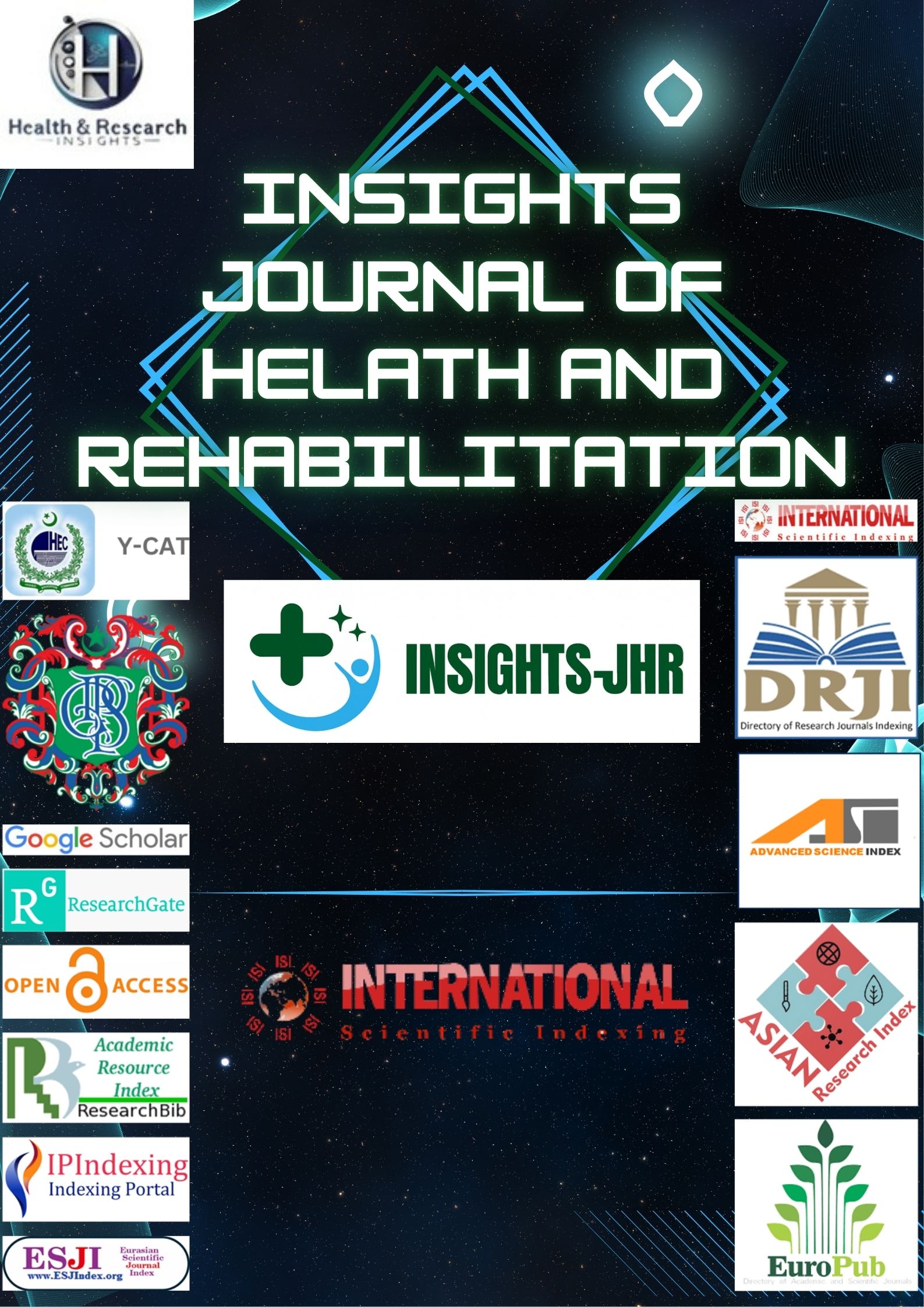KNOWLEDGE OF POLYCYSTIC OVARY SYNDROME AMONG PHYSICAL THERAPISTS WORKING IN PRIVATE AND PUBLIC HOSPITALS OF PESHAWAR: A CROSS- SECTIONAL STUDY
DOI:
https://doi.org/10.71000/f5x31f67Keywords:
Polycystic Ovary Syndrome, Knowledge, Physical Therapists, Pakistan, Exercise Therapy, Reproductive Health, Women’s HealthAbstract
Background: Polycystic Ovary Syndrome (PCOS) is one of the most common endocrine disorders among women of reproductive age, characterized by menstrual irregularities, hyperandrogenism, and metabolic complications. Globally, PCOS prevalence ranges between 4% and 20%, yet awareness among healthcare professionals, particularly physiotherapists, remains inadequate. Physiotherapists play a central role in promoting lifestyle modifications, including exercise and physical activity, which are first-line strategies for managing PCOS. Despite this, evidence from Pakistan exploring physiotherapists’ knowledge on PCOS is limited.
Objective: This study aimed to assess the knowledge of physiotherapists in Peshawar regarding PCOS and to determine associations between knowledge levels and demographic or professional characteristics.
Methods: A descriptive cross-sectional study was conducted between July and December 2024 among 152 physiotherapists working in public and private hospitals in Peshawar. Participants were recruited through a census approach, ensuring inclusion of the entire accessible population. Eligibility required at least six months of professional experience. Data were collected using a structured, validated, self-administered questionnaire consisting of 20 items, which was piloted for reliability (Cronbach’s alpha = 0.903). Knowledge scores were categorised as poor (≤31) or good (>31). Data were analyzed using SPSS version 22, applying descriptive statistics and Chi-square tests, with p < 0.05 considered significant.
Results: Among the 152 participants, 80 (53%) were male and 72 (47%) were female. Overall, 83 (54.6%) demonstrated poor knowledge of PCOS, while 69 (45.4%) exhibited good knowledge. Gender was significantly associated with knowledge levels (p = 0.028), with 46 males displaying good knowledge compared to 23 females. No significant associations were found with age (p = 0.326), specialty (p = 0.207), work experience (p = 0.449), number of workshops attended (p = 0.963), patients managed (p = 0.10), or family history (p = 0.274).
Conclusion: The study highlights considerable knowledge gaps among physiotherapists in Peshawar, particularly among female professionals. These findings underscore the urgent need for targeted educational programs, awareness initiatives, and curriculum integration of women’s health to strengthen multidisciplinary management of PCOS and improve patient outcomes.
References
Hulke N, Dutta S, Taksande AB. Atypical Manifestation of Acute Myocardial Infarction (AMI) in a Vicenarian Woman With Polycystic Ovary Syndrome (PCOS) Undergoing Assisted Reproductive Technology (ART) Treatment: A Case Report. Cureus. 2024;16(4):e57537.
Umamaheswar M, Bhatbolan SS. Barriers and facilitators to exercise participation in women with polycystic ovary syndrome: a qualitative study. BMJ Public Health. 2025;3(1):e000707.
Henderickx J, Viviers PL, Kirby JH. Case report - midfoot pain in a collegiate athlete with polycystic ovaries: digging deeper into bones and hormones. S Afr J Sports Med. 2025;37(1):v37i1a20221.
Szafarowska M, Rosiński M, Segiet-Święcicka A, Jędrzejczyk S, Jerzak M, Jerzak M. Effect of physiotherapy on infertility treatment in polycystic ovary syndrome patients. Prz Menopauzalny. 2024;23(1):14-20.
Munir M, Baig AA, Zafar Z. Effect of physiotherapy on polycystic ovarian syndrome and lack of research. J Pak Med Assoc. 2022;72(10):2130.
Nazir S, Sadhu S. Effect of pilates on regulating menstrual cycle in females with polycystic ovarian syndrome. Eur J Obstet Gynecol Reprod Biol X. 2024;21:100271.
Szymański JK, Słabuszewska-Jóźwiak A, Jakiel G. Fowler's Syndrome-The Cause of Urinary Retention in Young Women, Often Forgotten, but Significant and Challenging to Treat. Int J Environ Res Public Health. 2021;18(6).
Stańczak NA, Grywalska E, Dudzińska E. The latest reports and treatment methods on polycystic ovary syndrome. Ann Med. 2024;56(1):2357737.
Di Lorenzo M, Cacciapuoti N, Lonardo MS, Nasti G, Gautiero C, Belfiore A, et al. Pathophysiology and Nutritional Approaches in Polycystic Ovary Syndrome (PCOS): A Comprehensive Review. Curr Nutr Rep. 2023;12(3):527-44.
Stener-Victorin E, Teede H, Norman RJ, Legro R, Goodarzi MO, Dokras A, et al. Polycystic ovary syndrome. Nat Rev Dis Primers. 2024;10(1):27.
Sadeghi HM, Adeli I, Calina D, Docea AO, Mousavi T, Daniali M, et al. Polycystic Ovary Syndrome: A Comprehensive Review of Pathogenesis, Management, and Drug Repurposing. Int J Mol Sci. 2022;23(2).
Mardon AK, Leake HB, Szeto K, Astill T, Hilton S, Moseley GL, et al. Treatment recommendations for the management of persistent pelvic pain: a systematic review of international clinical practice guidelines. Bjog. 2022;129(8):1248-60.
Goh JE, Farrukh MJ, Keshavarzi F, Yap CS, Saleem Z, Salman M, et al. Assessment of prevalence, knowledge of polycystic ovary syndrome and health-related practices among women in klang valley: A cross-sectional survey. Front Endocrinol (Lausanne). 2022;13:985588.
Sadeghi HM, Adeli I, Calina D, Docea AO, Mousavi T, Daniali M, et al. Polycystic Ovary Syndrome: A Comprehensive Review of Pathogenesis, Management, and Drug Repurposing. Int J Mol Sci. 2022;23(2).
Deswal R, Narwal V, Dang A, Pundir CS. The Prevalence of Polycystic Ovary Syndrome: A Brief Systematic Review. J Hum Reprod Sci. 2020;13(4):261-71.
Rizvi M, Islam MA, Aftab MT, Naqvi AA, Jahangir A, Ishaqui AA, et al. Knowledge, attitude, and perceptions about polycystic ovarian syndrome, and its determinants among Pakistani undergraduate students. PLoS One. 2023;18(5):e0285284.
Sehar S. Assessment of Knowledge regarding Polycystic Ovary Syndrome (PCOS) among Nursing Students. International Journal of Nursing & Midwifery Research. 2021;07:42-5.
Rao M, Broughton KS, LeMieux MJ. Cross-sectional Study on the Knowledge and Prevalence of PCOS at a Multiethnic University. Progress in Preventive Medicine. 2020:e0028.
Zaitoun B, Al Kubaisi A, AlQattan N, Alassouli Y, Mohammad A, Alameeri H, et al. Polycystic ovarian syndrome awareness among females in the UAE: a cross-sectional study. BMC Womens Health. 2023;23(1):181.
Chemerinski A, Cooney L, Shah D, Butts S, Gibson-Helm M, Dokras A. Knowledge of PCOS in physicians-in-training: identifying gaps and educational opportunities. Gynecol Endocrinol. 2020;36(10):854-9.
Alruwaili G, Mohammad S, Almoaibed F, Badawi F, Alruwaili R, Alkholaifi M, et al. General public awareness toward polycystic ovarian syndrome among females in Saudi Arabia. International Journal of Medicine in Developing Countries. 2020:1847-53.
Downloads
Published
Issue
Section
License
Copyright (c) 2025 Muhammad Mustafa Durrani, Huma Hameed, Remsha, Umair Rauf (Author)

This work is licensed under a Creative Commons Attribution-NonCommercial-NoDerivatives 4.0 International License.







